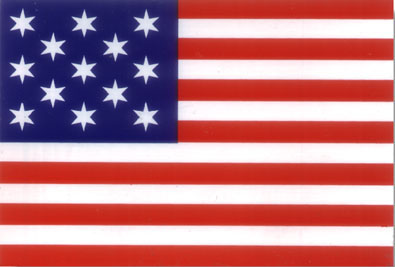Francis Hopkinson Flag Designer

Flags of the USA by David Eggenberger, 1964, p. 46.
Unpaid bills for Flag Designing
Of all the “legitimate” claims made for originating the Stars and Stripes only one was publicly stated contemporaneously with the adoption of the flag. The claimant was Francis Hopkinson of New Jersey, one of the signers of the Declaration of Independence. Hopkinson's claim is also unique in that it was advanced by the man himself — not by a devoted descendent, a romantic versifier, or a sentimental antiquarian.
Hopkinson was a man of demonstrated literary ability* and a student of heraldry. Elected to the Continental Congress June 1776, he resigned in November to serve as chairman of a three-man Naval Board, the executive arm of the Congress' Marine Committee at Philadelphia. He later served as Treasurer of Loans for the United States and as judge of admiralty for the state of Pennsylvania, In 1750 Hopkinson publicized his self-confessed contribution to the flag in a letter to the Board of Admiralty, the first successor to the Marine Committee.
After expressing pleasure at the Admiralty Board's approval of the device he had submitted for its official seal Hopkinson wrote:
I have with great readiness upon several occasions exerted my small abilities in this way for the public service, as I flatter myself, to the satisfaction of those I wish to please, Viz:For these services he asked for “a quarter cask of the public wine” as “proper and reasonable reward for these labours of fancy and a suitable encouragement to others of the like nature.”
The Flag of the United States of America.
Seven devices for the Continental Currency.
A Seal for the Board of Treasury
A Great Seal for the United States of America, with a Reverse.
Had Hopkinson's request been granted it would have established beyond doubt the identity of the flag designer. But no payment in “public wine” or anything else was made. A more formal bill was then presented to the Congress asking payment for the design of “the great Naval Flag of the United States” and numerous other items. (The national flag and the naval ensign, or “great Naval Flag,” have always been one and the same.) This time the total charges were not expressed in terms of thirst but in “hard money,” amounting to $7200 (£2700) Continental money, at sixty for one.
For four months the bill was bucked back and forth within the Treasury Department. Finally, on October 27, 1780, payment was refused. It was explained that Hopkinson could not claim authorship because he “was not the only person consulted on those exhibitions of Fancy.” The Congress confirmed this judgment on August 23, 1781, when it resolved That the report relative to the fancy-work of F. Hopkinson ought not be acted on.
* His best-known work was a humorous ballad “The Battle of the Kegs,” which described an incident on the Delaware River during the British occupation of Philadelphia.